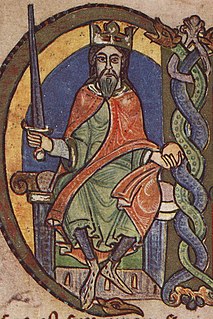
David I or Dauíd mac Maíl Choluim was a 12th-century ruler who was Prince of the Cumbrians from 1113 to 1124 and later King of Scotland from 1124 to 1153. The youngest son of Malcolm III and Margaret of Wessex, David spent most of his childhood in Scotland, but was exiled to England temporarily in 1093. Perhaps after 1100, he became a dependent at the court of King Henry I. There he was influenced by the Anglo-French culture of the court.

Dryburgh Abbey, near Dryburgh on the banks of the River Tweed in the Scottish Borders, was nominally founded on 10 November (Martinmas) 1150 in an agreement between Hugh de Morville, Constable of Scotland, and the Premonstratensian canons regular from Alnwick Abbey in Northumberland. The arrival of the canons along with their first abbot, Roger, took place on 13 December 1152.

Fergus of Galloway was a twelfth-century Lord of Galloway. Although his familial origins are unknown, it is possible that he was of Norse-Gaelic ancestry. Fergus first appears on record in 1136, when he witnessed a charter of David I, King of Scotland. There is considerable evidence indicating that Fergus was married to an illegitimate daughter of Henry I, King of England. It is possible that Elizabeth Fitzroy was the mother of Fergus's three children.
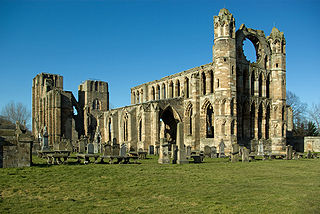
Elgin Cathedral is a historic ruin in Elgin, Moray, north-east Scotland. The cathedral—dedicated to the Holy Trinity—was established in 1224 on land granted by King Alexander II outside the burgh of Elgin and close to the River Lossie. It replaced the cathedral at Spynie, 3 kilometres (1.9 mi) to the north, that was served by a small chapter of eight clerics. The new and bigger cathedral was staffed with 18 canons in 1226 and then increased to 23 by 1242. After a damaging fire in 1270, a rebuilding programme greatly enlarged the building. It was unaffected by the Wars of Scottish Independence but again suffered extensive fire damage in 1390 following an attack by Robert III's brother Alexander Stewart, Earl of Buchan, also known as the Wolf of Badenoch. In 1402 the cathedral precinct again suffered an incendiary attack by the followers of the Lord of the Isles. The number of clerics required to staff the cathedral continued to grow, as did the number of craftsmen needed to maintain the buildings and surrounds.

Andrew Forman was a Scottish diplomat and prelate who became Bishop of Moray in 1501, Archbishop of Bourges in France, in 1513, Archbishop of St Andrews in 1514 as well as being Commendator of several monasteries.
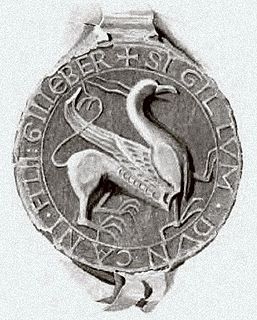
Donnchadh was a Gall-Gaidhil prince and Scottish magnate in what is now south-western Scotland, whose career stretched from the last quarter of the 12th century until his death in 1250. His father, Gille-Brighde of Galloway, and his uncle, Uhtred of Galloway, were the two rival sons of Fergus, Prince or Lord of Galloway. As a result of Gille-Brighde's conflict with Uhtred and the Scottish monarch William the Lion, Donnchadh became a hostage of King Henry II of England. He probably remained in England for almost a decade before returning north on the death of his father. Although denied succession to all the lands of Galloway, he was granted lordship over Carrick in the north.
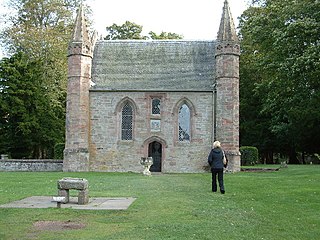
Scone Abbey was a house of Augustinian canons located in Scone, Perthshire (Gowrie), Scotland. Dates given for the establishment of Scone Priory have ranged from 1114 A.D. to 1122 A.D. However, historians have long believed that Scone was before that time the center of the early medieval Christian cult of the Culdees. Very little is known about the Culdees but it is thought that a cult may have been worshiping at Scone from as early as 700 A.D. Archaeological surveys taken in 2007 suggest that Scone was a site of real significance even prior to 841 A.D., when Kenneth MacAlpin brought the Stone of Destiny, Scotland's most prized relic and coronation stone, to Scone.

The Abbot and then Commendator of Melrose was the head of the monastic community of Melrose Abbey, in Melrose in the Borders region of Scotland. The abbots of the earlier Northumbrian foundation from Lindisfarne are not included here. The second abbey was founded in 1136 on the patronage of David I, King of Scots, by Cistercian monks from Rievaulx Abbey, Yorkshire. Control of the abbey was secularized in the 16th century and after the accession of James Stewart, the abbey was held by commendators. The last commendator, James Douglas of Lochleven, resigned the abbacy to William Douglas, 6th Earl of Morton in December 1606, and the abbey itself to the king in 1608. The abbey was then erected into a secular lordship for viscount Haddington, John Ramsay, who in 1609 was created "Lord Melrose". Lochleven however resumed the title of commendator in 1613 until his death in 1620.

Jocelin was a twelfth-century Cistercian monk and cleric who became the fourth Abbot of Melrose before becoming Bishop of Glasgow, Scotland. He was probably born in the 1130s, and in his teenage years became a monk of Melrose Abbey. He rose in the service of Abbot Waltheof, and by the time of the short abbacy of Waltheof's successor Abbot William, Jocelin had become prior. Then in 1170 Jocelin himself became abbot, a position he held for four years. Jocelin was responsible for promoting the cult of the emerging Saint Waltheof, and in this had the support of Enguerrand, Bishop of Glasgow.
The Abbot of Kelso was the head of the Tironensian monastic community at Kelso Abbey in the Scottish Borders. Originally, he was the Abbot of Selkirk, because from its foundation in 1113 by David, Prince of the Cumbrians (1113–1124) until it was moved to Kelso by David and John, bishop of Glasgow in 1127. The abbot was the first in Scotland to be granted the mitre in 1165. In the 16th century the monastery increasingly came under secular control, and finally in 1607 it was granted as a secular lordship (Holydean) to its last commendator, Robert Ker of Cesford, later earl of Roxburghe. The following is a list of abbots and commendators:
Walter FitzAlan was a twelfth-century Scottish magnate and Steward of Scotland. He was a younger son of Alan fitz Flaald and Avelina de Hesdin. In about 1136, Walter entered into the service of David I, King of Scotland. He became the king's dapifer or steward in about 1150, and served as such for three successive Scottish kings: David, Malcolm IV, and William I. In time, the stewardship became hereditarily-held by Walter's descendants.
The Abbot of Glenluce was the head of the monastic community of Glenluce Abbey, Galloway. The monastery was founded in 1192 by monks from Dundrennan Abbey with the patronage of Lochlann (Roland), Lord of Galloway. In the 16th century the monastery increasingly came under the control of secular warlords. In 1560 the monastery was occupied by James Gordon of Lochinvar, and the monks were expelled. However, soon after, Thomas Hay, a follower of the earl of Cassillis, was installed in the monastery as commendator and the monks were allowed to return. However, monastic life seems to have disappeared by the end of the century. In 1602 parliament granted the lands of the monastery to Lawrence Gordon as a secular lordship. The abbey was finally given to the bishop of Galloway in 1619. The following is a list of abbots and abbot-commendators:
The Abbot of Jedburgh was the head of the Augustinian canons of Jedburgh Abbey, Roxburghshire. It was founded by King David I of Scotland in 1138, and David's grandson and successor Máel Coluim IV ensured its promotion to the status of abbey before 1156. The position was secularized in the 16th century, and in 1606 turned into a secular lordship for the last commendator, Alexander Home, now earl of Home.
Hugh de Morville of Appleby in Westmorland, England, hereditary Constable of Scotland, was a Norman knight who made his fortune in the service of David FitzMalcolm (d.1153), Prince of the Cumbrians, later King of Scotland.

Political and military events in Scotland during the reign of David I are the events which took place in Scotland during David I of Scotland's reign as King of Scots, from 1124 to 1153. When his brother Alexander I of Scotland died in 1124, David chose, with the backing of Henry I of England, to take the Kingdom of Alba for himself. David was forced to engage in warfare against his rival and nephew, Máel Coluim mac Alaxandair. Subduing the latter took David ten years, and involved the destruction of Óengus, mormaer of Moray. David's victory allowed him to expand his control over more distant regions theoretically part of the Kingdom. In this he was largely successful, although he failed to bring the Earldom of Orkney into his kingdom.

The Davidian Revolution is a name given by many scholars to the changes which took place in the Kingdom of Scotland during the reign of David I (1124–1153). These included his foundation of burghs, implementation of the ideals of Gregorian Reform, foundation of monasteries, Normanization of the Scottish government, and the introduction of feudalism through immigrant Norman and Anglo-Norman knights.

Historical treatment of David I and the Scottish church usually emphasises King David I of Scotland's pioneering role as the instrument of diocesan reorganisation and Norman penetration, beginning with the bishopric of Glasgow while David was Prince of the Cumbrians, and continuing further north after David acceded to the throne of Scotland. As well as this and his monastic patronage, focus too is usually given to his role as the defender of the Scottish church's independence from claims of overlordship by the Archbishop of York and the Archbishop of Canterbury.
Ada de Warenne was a Scottish princess, the Anglo-Norman wife of Henry of Scotland, Earl of Northumbria and Earl of Huntingdon. She was the daughter of William de Warenne, 2nd Earl of Surrey by Elizabeth of Vermandois, and a great-granddaughter of Henry I of France. She was the mother of Malcolm IV and William I of Scotland.
William was a 12th-century prelate based in the Kingdom of Scotland. He occurs in the records for the first time, 1152 x 1153, late in the reign of King David I of Scotland (1124–53) witnessing a grant from that monarch of the church of Clackmannan to the Abbot of Cambuskenneth. By this point in time he is already Bishop of Moray. The date of his accession is not known; all that can be said is that he must have become bishop some time, perhaps some considerable time, after 1128, the last certain point in the floruit of his predecessor Gregoir.
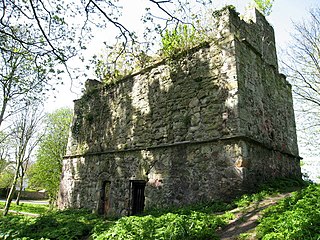
St. Mary's Priory, North Berwick, was a monastery of nuns in medieval East Lothian, Scotland. Founded by Donnchad I, Earl of Fife around 1150, the priory lasted for more than four centuries, declining and disappearing after the Scottish Reformation. It had been endowed by the Earls of Carrick as well as the Earls of Fife, but over time lost its dependence on these and came to be controlled by the more locally based Home family, who eventually acquired the priory's lands as a free barony.











